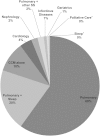Critical Care Medicine and Infectious Diseases: An Emerging Combined Subspecialty in the United States
- PMID: 25944345
- PMCID: PMC4542599
- DOI: 10.1093/cid/civ360
Critical Care Medicine and Infectious Diseases: An Emerging Combined Subspecialty in the United States
Abstract
The recent rise in unfilled training positions among infectious diseases (ID) fellowship programs nationwide indicates that ID is declining as a career choice among internal medicine residency graduates. Supplementing ID training with training in critical care medicine (CCM) might be a way to regenerate interest in the specialty. Hands-on patient care and higher salaries are obvious attractions. High infection prevalence and antibiotic resistance in intensive care units, expanding immunosuppressed host populations, and public health crises such as the recent Ebola outbreak underscore the potential synergy of CCM-ID training. Most intensivists receive training in pulmonary medicine and only 1% of current board-certified intensivists are trained in ID. While still small, this cohort of CCM-ID certified physicians has continued to rise over the last 2 decades. ID and CCM program leadership nationwide must recognize these trends and the merits of the CCM-ID combination to facilitate creation of formal dual-training opportunities.
Keywords: critical care; fellowship; infectious disease.
Published by Oxford University Press on behalf of the Infectious Diseases Society of America 2015. This work is written by (a) US Government employee(s) and is in the public domain in the US.
Figures
Similar articles
-
Synergy, Salary, and Satisfaction: Benefits of Training in Critical Care Medicine and Infectious Diseases Gleaned From a National Pilot Survey of Dually Trained Physicians.Clin Infect Dis. 2016 Oct 1;63(7):868-875. doi: 10.1093/cid/ciw441. Epub 2016 Jun 29. Clin Infect Dis. 2016. PMID: 27358351 Free PMC article.
-
Formalization of a Specialty-Specific Military Unique Curriculum: A Joint United States Army and United States Air Force Infectious Disease Fellowship Program.Mil Med. 2019 Oct 1;184(9-10):509-514. doi: 10.1093/milmed/usz006. Mil Med. 2019. PMID: 30793189
-
The Leaders in Epidemiology, Antimicrobial Stewardship, and Public Health (LEAP) Fellowship, a Novel Training Program in Public Health for Infectious Diseases Physicians.Clin Infect Dis. 2024 Jun 14;78(6):1536-1541. doi: 10.1093/cid/ciad787. Clin Infect Dis. 2024. PMID: 38267206
-
Critical care medicine training and certification for emergency physicians.Crit Care Med. 2005 Sep;33(9):2104-9. doi: 10.1097/01.ccm.0000173412.43562.b3. Crit Care Med. 2005. PMID: 16148486 Review.
-
[Infectious diseases - a specialty of internal medicine].Internist (Berl). 2018 Apr;59(4):334-340. doi: 10.1007/s00108-018-0387-4. Internist (Berl). 2018. PMID: 29459991 Review. German.
Cited by
-
Establishing an artificial intelligence-based predictive model for long-term health-related quality of life for infected patients in the ICU.Heliyon. 2024 Jul 31;10(15):e35521. doi: 10.1016/j.heliyon.2024.e35521. eCollection 2024 Aug 15. Heliyon. 2024. PMID: 39170285 Free PMC article.
-
Key Takeaways From the U.S. CDC's 2019 Antibiotic Resistance Threats Report for Frontline Providers.Crit Care Med. 2020 Jul;48(7):939-945. doi: 10.1097/CCM.0000000000004371. Crit Care Med. 2020. PMID: 32282351 Free PMC article. No abstract available.
-
Combined Medicine-Pediatrics Fellowships: A Guide for Fellowship Directors and Residents.Cureus. 2021 Jun 16;13(6):e15688. doi: 10.7759/cureus.15688. eCollection 2021 Jun. Cureus. 2021. PMID: 34277277 Free PMC article.
-
Effects of COVID-19 on career and specialty choices among Chinese medical students.Med Educ Online. 2021 Dec;26(1):1913785. doi: 10.1080/10872981.2021.1913785. Med Educ Online. 2021. PMID: 33849405 Free PMC article.
-
Critical Theory or Accepted Practice? Combining Careers in Critical Care Medicine and Gastroenterology.Dig Dis Sci. 2022 Jul;67(7):2727-2729. doi: 10.1007/s10620-022-07570-0. Epub 2022 Jun 3. Dig Dis Sci. 2022. PMID: 35661062 Free PMC article. No abstract available.
References
-
- Vincent JL, Rello J, Marshall J, et al. International study of the prevalence and outcomes of infection in intensive care units. JAMA 2009; 302:2323–9. - PubMed
-
- Boucher HW, Talbot GH, Bradley JS, et al. Bad bugs, no drugs: no ESKAPE! An update from the Infectious Diseases Society of America. Clin Infect Dis 2009; 48:1–12. - PubMed
-
- Kumar A, Roberts D, Wood KE, et al. Duration of hypotension before initiation of effective antimicrobial therapy is the critical determinant of survival in human septic shock. Crit Care Med 2006; 34:1589–96. - PubMed
-
- Halpern NA, Pastores SM. Critical care medicine in the United States 2000–2005: an analysis of bed numbers, occupancy rates, payer mix, and costs. Crit Care Med 2010; 38:65–71. - PubMed
Publication types
MeSH terms
Grants and funding
LinkOut - more resources
Full Text Sources
Other Literature Sources
Medical


